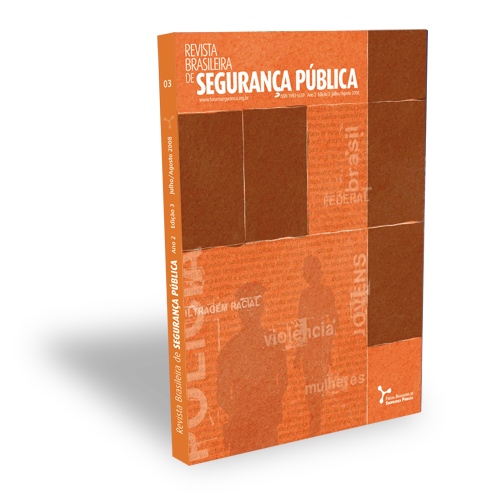Prevenindo a delinqüência violenta nos jovens
DOI:
https://doi.org/10.31060/rbsp.2008.v2.n1.28Palavras-chave:
Delinqüência, Juventude, Prevenção do crime, Escola, Família.Resumo
Este trabalho sugere um referencial para pensar a prevenção da violência juvenil. A decisão sobre quais medidas deprevenção do crime devem ser tomadas começa pela análise não só da efetividade, mas também dos custos dasmedidas em diferentes circunstâncias. O segundo passo é igualmente difícil: a intervenção deve ser focalizada nalocalidade específica onde o problema está acontecendo, ou seja, o foco deve recair sobre aspectos mais gerais, comoa juventude, a comunidade e a família, que influenciam as possibilidades de os jovens cometerem delitos. Trata-sede escolhas difíceis. É muito importante, contudo, conhecer as conseqüências das abordagens escolhidas. Do mesmomodo, é igualmente relevante considerar os efeitos da não opção por outras abordagens.
Downloads
Referências
CHAMLIN, M. B.; COCHRAN, J. K. Social altruism and crime. Criminology, v. 35, p. 203-227, 1997.
CLARKE, R. V. Situational crime prevention. In: TONRY, M.; FARRINGTON, D.P. (Eds.). Crime and Justice. A Review of Research,Chicago, University of Chicago Press, 1995, v. 19, 1995.
DALY, M.; WILSON, M.; VASDEV, S. Income inequality and homicide rates in Canada and the United States. Canadian Journal of Criminology, v. 43, p. 219-236, 2001.
FELSON, M. et alii. Redesigning hell: preventing crime and disorder at the port authority bus terminal.
CLARKE, V. (Ed.). Preventing Mass Transit Crime, New York, Criminal Justice Press Crime Prevention Studies, v. 6, 1996.
FRONZO, J. de; HANNON, L. Welfare assistance levels and homicide rates. Homicide Studies, v. 2, p. 31-45, 1998a.
FRONZO, J. de; HANNON, L. Welfare and property crime. Justice Quarterly, v. 15, p. 273-287, 1998b.
GOTTFREDSON, D. C. Chapter 3: school effects. In: GOTTFREDSON, D. C. Schools and delinquency. Cambridge: Cambridge University Press, 2001, p. 90-91.
JENKINS, J.M. Early intervention to prevent the development of delinquency. In: KIDD, B.; PHILIPS, J. (Eds.). From enforcement and prevention to civic engagement: research on community safety. University of Toronto: Centre of Criminology, 2004, p. 125-139.
MAZEROLLE, L. G.; KADLECK, C. ROEHL, J. Controlling drug and disorder problems: the role of place managers. Criminology, v. 38, p. 371-403, 1998.
OLDS, D. Long-term effects of nurse home visitation on children’s criminal and antisocial behaviour. Journal of the American Medical Association, v. 280, p. 1.238-1.244, 1998.
PAINTER, K. A.; FARRINGTON, D. P. Evaluating situational crime prevention using a young people’s survey. British Journal of Criminology, vol. 41, p. 266-284, 2001.
PETROSINO, A.; TURPIN PETROSINO, C.; BUEHLER, J. Scared straight and other juvenile. Awareness programs for preventing juvenile delinquency: a systematic review of the randomized experimental evidence. Annals of the American Academy of Political and Social Science, v. 589, p. 41-62, setembro de 2003.
SAMPSON, R. J.; RAUDENBUSH, S. W.; EARLS, F. Neighbourhoods and violent crime: a multilevel study of collective efficacy. Science, n. 277, p. 918-924, agosto de 1997.
SAVOIE, J. Homicide in Canada, 2002,Ottawa, Juristat, v. 3, n. 8, 2003.
SIMONS, R. L.; WU, C.I.; LIN, K.H.; GORDON, L.; CONGER, R. D. A cross cultural examination of the link between Corporal Punishment and Adolescent Antisocial Behaviour. Criminology, v. 38, p. 47-79, 2000,.
SMITH, C.; LIZOTTE, A. J.; THORNBERRY, T. P. Resilient youth: identifying factors that prevent high risk. Youth from engaging in delinquency and drug use. Current Perspectives on Aging and the Life Cycle, v. 4, p. 217-247, 1995.
SNYDER, H.; SICKMUND, M. Juvenile offenders and victims: 1999 national report. Washington, D.C.: Office of Juvenile Justice and Delinquency Prevention, 1999.
STEINBERG, L. Youth violence: do parents and families make a difference? National Institute of Justice Journal,p. 31-38, abril de 2000.
TONRY, M.; FARRINGTON, D.P. Strategic approaches to crime prevention. In: TONRY, M.; FARRINGTON, D.P. (Eds.). Crime and Justice. A Review of Research, Chicago, University of Chicago Press, 1995, v. 19, 1995.
UNIVERSIDADE DE MARYLAND. Departamento de Criminologia e Justiça Criminal. Preventing crime: what works, what doesn’t, what’s promising. Washington, D.C.: Departmento de Justiça dos Estados Unidos, Gabinete dos Programas de Justiça, 1997.
WEBSTER, C.M. Limits of justice: the role of the criminal justice system in addressing the problem of crime. In: KIDD, B.; PHILIPS, J. (Eds.). From enforcement and prevention to civic engagement: research on community safety. University of Toronto: Centre of Criminology, 2004, p. 96-124.
WELSH, W. N. Effects of student and school factors on five measures of school disorder. Justice Quarterly, v. 18, p. 911-947, 2001.
Downloads
Publicado
Como Citar
Edição
Seção
Licença
Copyright (c) 2012 Revista Brasileira de Segurança Pública

Este trabalho está licenciado sob uma licença Creative Commons Attribution 4.0 International License.
Licenciamento
A Revista Brasileira de Segurança Pública usa a Licença Creative Commons como forma de licenciamento para suas obras publicadas. A licença utilizada segue o modelo CC BY 4.0 - Attribution 4.0 International.
Para consultar os dirietos permitidos direcione-se para a licença completa ou para a nossa página de Direitos dos autores e Licenças.



